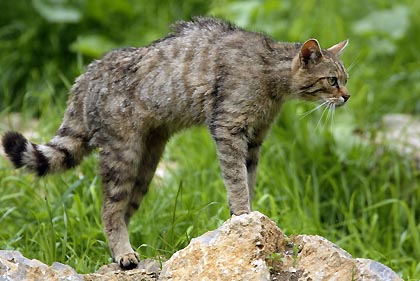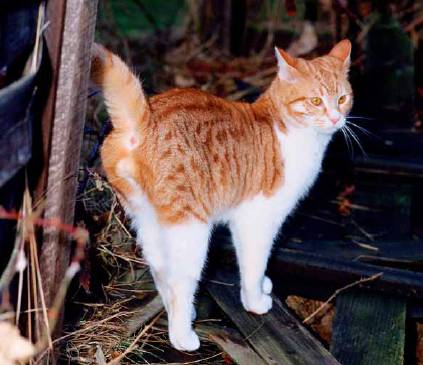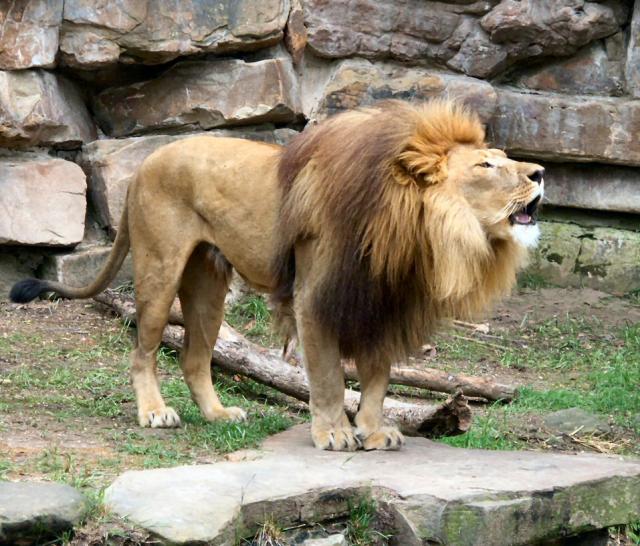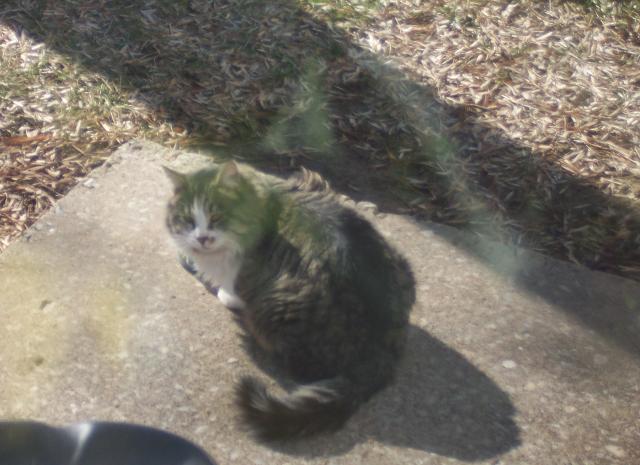What is a Feral Cat?
-
A feral cat is a domesticated cat that has had very little or no human contact and has reverted to its ancestral or wild state. These cats have followed thier instincts and live on thier own. If you want to understand how these cats live, why they do the things they do, and why TNR works. I believe it is necessary to review some history and how this relates to thier social structure. I have posted links to other sites that give comprehensive overviews of similar concepts.
Some History
It is believed that the domestic cat Felis silvestris catus, most likely derived from three subspecies of the "Wildcat." One is the Desert Wildcat, Felis silvestris lybica, the African Wildcat Felis s. cafra, and the European Wildcat Felis s. sylvestris. Most likely the cats were attracted to areas where Egyptians or Middle Eastern agrarian civilizations stored grains. This is where the rodents were, and the cats ate the rodents, providing a service to the people. Man allowed the cats protection while they provided a free exterminator. The relationship grew and man began the art of artifical selection.
The larger bodied cat breeds such as British Shorthair, and Main Coon, all most likely came from the European Wildcat. Whereas more slender breeds such as the Abysynnian, and Oriental Shorthair were bred from the African and/or Desert Wildcat. The huge variations in size and shape that is seen in dog breeds is not prevelant in cats. Historically most domestic cats are generally the same size and shape with exception of the Persian and newer breeds like the American Curl. In fact, if a black shorthaired cat were compared to the black variety of its Wild ancestor you would notice almost no difference. This is why feral cats can so easily revert back to thier wild state succesfully.
 
As you can see here at left, the African Wildcat has a more slender build compared to the European Wildcat seen right.
Social Structure
THE ROLE OF RESOURCES: Firstly, all cats except Lions are solitary by nature. Domestic (feral) cats congregate due to unaturally high concentrations of food from humans. The size and distribution of a feral cat colony depends largely on resources. If there is a reliable day to day food source such as a bowl of cat food that arrives regularly. The cats will congregate in dense numbers. They will eventually settle down and begin breeding because they do not have to worry as much about finding food.
If the cats live in an area where they are not fed they will be spread sparsly across the landscape. The less resources they have, the larger the home range (entire area it roams over the course of its life) of each cat. I have based my Territory estimates from the cats I see everyday.
TERRITORY SIZES: There are many different factors that affect the size of an individual feral cats territory. Age, sex, social status, being spayed or neutered, and as I mentioned before, resources. In areas with abundant food, territory may not even exist and overlap greatly. Newly weaned kittens have the smallest and lowest quality territories, often on the fringes of other cats. A large male may eat from a food bowl in the same colony but the kittens are forced to eat out of a dumpster or roam elsewhere. They may die if they do not find adequate resources. This often happens because the wildlife in the area has been depleted to the point where the only option for the feral cats is to live out of dumpsters or around man.
Spayed females have a slightly larger territory from the kittens, when they are sterilized they lose the urge to roam and advertise thier reproductive readiness by spraying objects and yowling. So they settle down and may live in an area less than an acre, as the ones do in my cat colony.
Females In tact have slightly larger territory than do sterlilized ones. Encompassing maybe an acre. If they are not pregant or nursing they will roam this area and advertise thier rediness to mate by spraying urine on variouse visible spots so roaming male cats can take a sniff and see if shes the one.
Neutered males are next, thiers is larger than the reproductive females but they too lose the urge to scent mark and patrol/defend large territorries for rival males and receptive female cats. It may only be slightly larger than an acre.
In tact subordinate males are the next size up. They are kept in check by the alpha males. Around here these cats live in an area of maybe 2 or 3 acres. They do alot behind the alpha males back, and if they are big enough they will begin passive agression challanges through scent marking and yowling. Sometimes these males try to mate with females and eat from the alpha males resources after he has eaten. Some roam some do not. Slick (the cat I caught recently) never really roamed or scent marked, and he was very much in tact. They usually obey thier status and the order remaines relatively stable.
The alpha males have the largest of all territories among feral cats. I say male(s) plural because in this cat colony I have noticed about three large males that stay in certain portions of the park. In the rear where I live, the top feral cat is scarface (the guy below). In the front, I hear there is a large manx cat that controls that area. The third is a rival to Scarface and is a longhaired gray main coon mix. Each of thier territories at most may be five or six acres. The manx and scarface never really come into conflict but scarface does not tolerate new feral cats especially males. He has even evicted two racoons from under my house. He patrols his territory every day, lots of scent marking, and lately yowling.

Here is a male cat scent marking, fertile females will do the same to advertise thier receptiveness.
This yowling to me seems like the tiny version of a lions roar. If anyone has heard a real lions roar, not the hollywood version you see before the movies, you know it is a deep bellow rather than a raspy growl. If you watch the male lions closely you see how much effort they put into this call and how thier abdomens tense when they do it. Its purpose is to let as many cats and critters know who this place belongs to. When I watch scarface and the gray rival male engage in this same activity I see they look just like the scaled down version of a male lion. They did the yowling and scent marking battle for about a week, and finally scarface came out the victor without any bloodshed.

Here is what a Lion actually looks like when it is roaring.
Neuter the alpha male? I have heard but am not sure how true this is, not to neuter the alpha male cat. Why? because he will keep out other feral cats and hold the same territory as long as he is in tact. But if he is not then he will lose that urge, step down from the throne and let it go to a newcomer.Then the colonies pecking order is thrown out of balance. This makes sense to me, so for now I will let him be. I will have to learn more on this, and maybe just save him for last.

This is Scarface
So there you have a messy crash course on feral cat social structure from my point of view. By no means do I say it is the solid truth or based on any real science, but hey its a start.
|